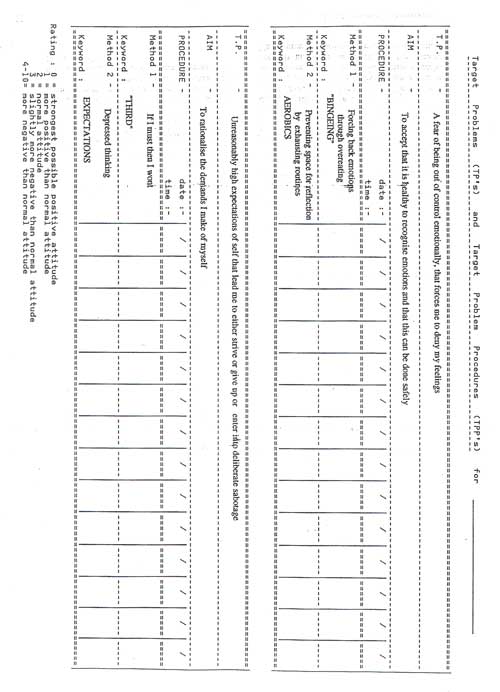On TP and TPP Rating Sheets
Harvey, L, 1993. On TP and TPP Rating Sheets. Reformulation, ACAT News Autumn, p.x.
On TP and TPP Rating Sheets
Linda Harvey
The TP and TPP rating sheet shown below was developed between a client and myself some time ago. I have found that this type of rating sheet works well for me and for my clients. The two major differences between it and the “original” rating sheet are:
- There is an assumption that there might well be more than one TPP feeding a TP. The number generally relates to how “global” the Target Problem is.
- There is no requirement to monitor either the Target Problem or the Aim. I make no apology for this as it has always seemed presumptuous to me to anticipate any change in these at an early stage in therapy. In the beginning, as it were, the research requirements made it an interesting exercise perhaps but - having established that the TPP’s needed to alter before the goal could be achieved or the symptoms alleviated - it now seems unnecessarily complicated to maintain this old procedure. I would be very interested to hear what other people feel about this.
On the front of each rating sheet is a space, under “method”, for a very brief outline of the TPP and a buzzword that is significant for the client as an abbreviated example of a typical TPP. On the reverse of the rating sheet each “method” is more exhaustively explained as a full-blown TPP. For clarity, I have included an actual example, with two TP’s. (‘The rating sheets can be adapted to include up to four “methods” per TP - in this case each TP will have its own rating sheet)
TP1
Method 1. Whenever I feel unhappy with my existence - often through an unfair experience
in life/work - rather than explore it I dam up the emotions with food. My self-disgust at such lack of control leads me to vomit (Actually my stomach is now unused to large meals, so I often feel uncomfortable after food even when I haven’t binged.)
Method 2. The thought of being alone with my thoughts is so disturbing that I fill my days with work, exercise and further studies, so that I feel permanently exhausted and rarely have time to eat properly. Not only does this affect my health - it acts as a permanent bar to reflection and personal growth. I no longer know what I am frightened of.
TP 2
Method 1. I am driven by the need to succeed but paradoxically fear failure. Sometimes it is easier to accept defeat at the beginning so I do not try at all.
Method 2. Expectation of success frightens me so I perform badly in my own eyes and do not do justice to my abilities. This makes me feel miserable so that my opinion of my
abilities sinks and I feel even less confident next time.
Reverse side of Rating Sheet shown below


Full Reference
Harvey, L, 1993. On TP and TPP Rating Sheets. Reformulation, ACAT News Autumn, p.x.Search the Bibliography
Type in your search terms. If you want to search for results that match ALL of your keywords you can list them with commas between them; e.g., "borderline,adolescent", which will bring back results that have BOTH keywords mentioned in the title or author data.
Related Articles
Research Into the Use of CAT Rating Sheets
Coombes, J., Taylor, K. and Tristram, E., 2009. Research Into the Use of CAT Rating Sheets. Reformulation, Winter, pp.28-29.
Service Innovation
Jenaway, A., Mortlock, D., 2008. Service Innovation. Reformulation, Summer, pp.31-32.
Financial Practicalities
Harvey, L., 2010. Financial Practicalities. Reformulation, Winter, p.46.
Blunt Thoughts about Sharpening the File
Morris, P., 1995. Blunt Thoughts about Sharpening the File. Reformulation, ACAT News Winter, p.x.
The Procedure Tracking Form (PTF): A Possible New Tool for CAT
Kingerlee, R., 2004. The Procedure Tracking Form (PTF): A Possible New Tool for CAT. Reformulation, Summer, pp.25-27.
Other Articles in the Same Issue
Meditation on the Phenomena of Anxiety in CAT Clinical Training
Dunn, M., 1993. Meditation on the Phenomena of Anxiety in CAT Clinical Training. Reformulation, ACAT News Autumn, p.x.
Modern Fairy Tales: Of Vampires and Batmen
Dunn, M., 1993. Modern Fairy Tales: Of Vampires and Batmen. Reformulation, ACAT News Autumn, p.x.
On TP and TPP Rating Sheets
Harvey, L, 1993. On TP and TPP Rating Sheets. Reformulation, ACAT News Autumn, p.x.
Some Subjective Ideas on the Nature of Object
Dunn, M., 1993. Some Subjective Ideas on the Nature of Object. Reformulation, ACAT News Autumn, p.2.
The Problem of Relating TPs and TPPs
Leiman, M., 1993. The Problem of Relating TPs and TPPs. Reformulation, ACAT News Autumn, p.x.
Tony Ryle Briefly Interviewed by Mark Dunn
Dunn, M. and Ryle, A., 1993. Tony Ryle Briefly Interviewed by Mark Dunn. Reformulation, ACAT News Autumn, p.x.
Validating Conceptual Aspects of the Reformulation Process in CAT
Donias, S., 1993. Validating Conceptual Aspects of the Reformulation Process in CAT. Reformulation, ACAT News Autumn, p.x.
Help
This site has recently been updated to be Mobile Friendly. We are working through the pages to check everything is working properly. If you spot a problem please email support@acat.me.uk and we'll look into it. Thank you.
